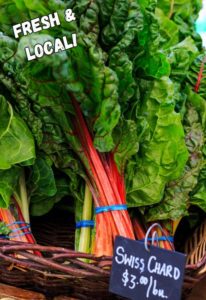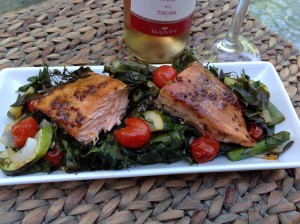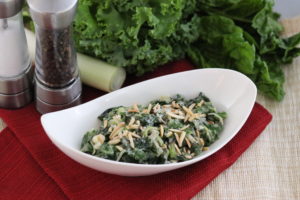 Do you assume that since summer is over, the farmers’ markets and fresh greens are winding down?
Do you assume that since summer is over, the farmers’ markets and fresh greens are winding down?
There are several varieties of dark leafy greens that make a comeback in the fall when the temperatures go down. They can taste even better after experiencing a few cold nights.
One of these we encourage you to seek out this time of year is…
Swiss chard!
When we talk about Swiss chard, we get responses like, “It must be healthy” and “It looks so pretty when I see it at the farmers’ market or the store.” And we also often hear, “I never buy it because I don’t know what to do with it!”
What is it?
 Swiss chard is a tall leafy green, native to southern Europe, and dates back to the fourth century B.C. It is very popular in Mediterranean cuisines and, in case you were wondering, chard is not native to Switzerland, despite its name. The speculation is that a Swiss botanist was responsible for determining chard’s scientific name and the “Swiss” just stuck.
Swiss chard is a tall leafy green, native to southern Europe, and dates back to the fourth century B.C. It is very popular in Mediterranean cuisines and, in case you were wondering, chard is not native to Switzerland, despite its name. The speculation is that a Swiss botanist was responsible for determining chard’s scientific name and the “Swiss” just stuck.
It’s considered part of the “goosefoot” family, along with beets and spinach, because its leaves resemble a goose’s foot. Swiss chard plants can grow as tall as 28 inches. They can tolerate the heat, and really thrive in cooler weather. They are often planted in the spring for an early summer harvest and again in the summer for a fall harvest. With their bright red, yellow, purple and orange stems, and large green leaves, they can be some of the most beautiful looking greens in your kitchen or garden!
Why Swiss chard?
Like all dark leafy greens, Swiss chard is absolutely loaded with nutritional benefits:
- Just one cup of Swiss chard has 300% of our recommended daily intake of Vitamin K, which helps improve bone health and prevent osteoporosis.
- With its high dietary nitrates, it helps reduce blood pressure.
- Swiss chard contains chlorophyll, which helps combat cancer among other benefits.
- As a multi-disease fighting vegetable, it has impressive amounts of phytonutrients with antioxidant and anti-inflammatory benefits, and it also helps regulate blood sugar.
How do you choose it and store it?
 Choose big, bright and vibrant!
Choose big, bright and vibrant!
We love buying Swiss chard at the farmers market, and you can also find it in many stores. Remember, the farmers’ market varieties are likely to be fresher and have a higher nutrient content. Look for bright green leaves and fresh cut stems. You want to avoid leaves that are wilted or turning yellow.
Store your Swiss chard loosely wrapped in plastic in the refrigerator, which will keep it fresh for a few days. Placing paper towels in the bag, between the leaves will help it stay fresh for up to a week. Rinse the leaves and stems just before using it to remove any dirt or grit. If you’re using it within a day, you can store it in a vase with water to show off the beautiful colors.
Do you have to cook Swiss chard?
Swiss chard is one of the plants, along with beets, beet greens, rhubarb, and turnip greens that contain oxalates, or also known as oxalic acid. Our bodies can produce it, but you can also get it from food. Once it’s consumed, oxalates bind to minerals to form compounds and most people process and eliminate these compounds with no issues. However, for some people with sensitivities, when they eat high oxalate diets, it can increase their risk of kidney stones.
To reduce the oxalate content of Swiss chard, you can boil it before sautéing it or adding it to other dishes. If Swiss chard is consumed in large quantities or eaten very frequently, it is recommended that you blanch, or boil it, for a short amount of time (about 3 minutes).
If you only eat it occasionally and prefer not to cook it, by combining high oxalate foods with dairy, such as milk, yogurt, or cheese, this can help neutralize the presence and absorption of the oxalates. Some people think Swiss chard has a slightly bitter taste when it is raw. Cooking it will also help to remove any perceived bitter taste.
Now the fun part…what can you do with Swiss Chard?
Yes, you can eat the leaves AND stems! Small, tender leaves are perfect to include in salads. If you are blanching or sautéing, and your stems are thicker than one inch, you may wish to give the stems a head start because they will require a little more time to soften and become tender. Watch Zonya show you one of our favorite quick and easy ways to enjoy Swiss chard…in the Swiss Chard with Raisins and Pine Nuts!
Some other great tasting ideas:
 Swiss Chard and Black Bean Enchiladas
Swiss Chard and Black Bean Enchiladas
Roasted Beets and Carrots with Goat Cheese Vinaigrette
Goat Cheese Chicken with Blueberry Salsa
Pan Roasted Honey Mustard Salmon and Veggies
 Open-Faced Smoky Greens and Beans
Open-Faced Smoky Greens and Beans
Swiss Chard and Bacon Quesadillas
Swiss Chard, Corn and Beans Sauté
Bell Pepper and Kale Hash with Fried Egg
Stir Fried Greens with Jalapeno and Ginger
Pomegranate Christmas Tree Salad
Too much of a good thing?
As you can see, Swiss chard is incredible! However, certain people may want to be careful not to go overboard. For example, if you take a blood thinner or have an issue with blood clotting, contact your physician before increasing your Swiss chard intake because the high concentration of Vitamin K can interfere with some anti-clotting medications. Also, anyone with kidney or gallbladder problems may want to talk to a nutritionist or physician regarding the appropriate amount of Swiss chard to include in their diets.
Enjoy the wonderful taste and nutrition of Swiss chard while it’s in-season!
Try Swiss chard in a variety of ways and please share your successes!
 LEARN MORE ABOUT THE NAPKIN!
LEARN MORE ABOUT THE NAPKIN!

That sounds delicious — thank you for sharing!